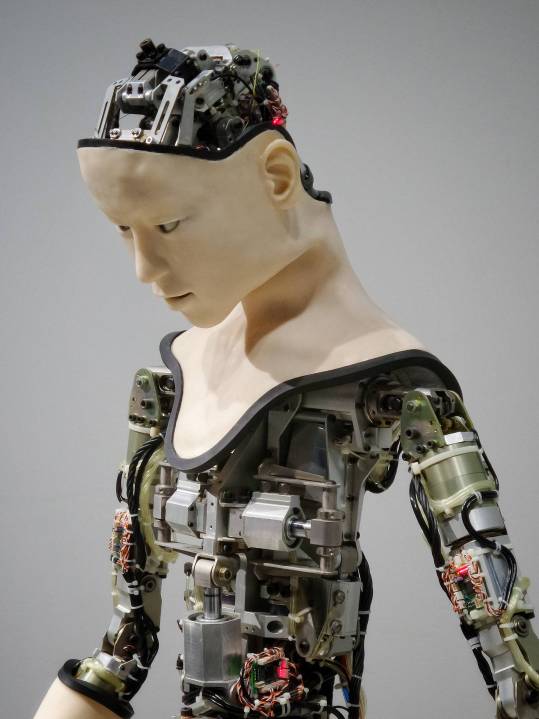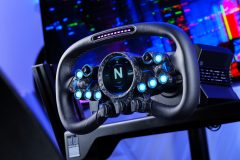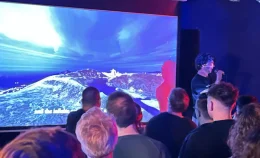The world of robotics is advancing at an astonishing pace, and the United Nations (UN) is at the forefront of exploring the potential of these technological marvels. In a groundbreaking event, the UN’s International Telecommunication Union hosted the world’s first news conference featuring humanoid social robots. The event, held at the AI for Good Global Summit in Geneva, aimed to stimulate discussions about the future of artificial intelligence (AI) and its role in addressing the UN’s sustainable development goals.
Nine robots, carefully crafted to resemble humans, took center stage at the news conference. Among them were Sophia, the UN Development Program’s first robot innovation ambassador, Grace, a robot designed for healthcare applications, and Desdemona, a rock star robot. Two other robots, Geminoid and Nadine, bore a striking resemblance to their creators. The presence of these robots not only showcased their capabilities but also highlighted the limitations of current robotic technologies.
While the event aimed to emphasize human-machine collaboration, it was evident that some of the robots relied on preprogrammed responses. Sophia, for instance, occasionally leaned on scripted answers crafted by a team of writers at Hanson Robotics. It is important to note that the extent to which the robots’ responses were scripted or programmed by humans was not explicitly stated.
The AI for Good Global Summit provided a platform to examine the possibilities of human-machine collaboration. The participating robots were designed to demonstrate how these technologies can contribute to achieving the UN’s sustainable development goals. From healthcare to innovation, these humanoid robots showcased the potential for AI to augment human capabilities and address pressing global challenges.
One of the standout robots at the conference was Grace, a healthcare robot. With advancements in AI and robotics, the healthcare industry has witnessed a transformation in patient care. Grace exemplifies this revolution by offering assistance to healthcare professionals, enhancing efficiency, and improving patient outcomes. Whether it’s monitoring vital signs, providing medication reminders, or offering companionship to patients, Grace showcases the potential of robots to augment human caregiving.
Sophia, the UNDP’s robot innovation ambassador, captivated the audience with her human-like appearance and advanced capabilities. Created by Hanson Robotics, Sophia represents a significant leap in humanoid robot technology. She can engage in conversations, recognize faces, and express a wide range of emotions. Sophia’s role as an ambassador for innovation highlights the UN’s commitment to leveraging technology for sustainable development.
Desdemona, the rock star robot, added a touch of entertainment to the news conference. While her performance may have seemed like a light-hearted addition, it underscored the potential for robots to engage and entertain audiences. Beyond entertainment, robots like Desdemona can play a role in education, tourism, and various other industries where human-like interactions are desirable.
Despite the impressive capabilities demonstrated by the humanoid robots, it became evident during the news conference that there are still limitations to overcome. Reporters were asked to speak slowly and clearly when addressing the robots, as the time lag in responses was attributed to internet connectivity rather than the robots themselves. Awkward pauses, audio problems, and inconsistent replies were encountered, highlighting the need for further advancements in robotics and AI.
During the Q&A session, it became apparent that some of the robots relied on scripted responses. This raises questions about the level of autonomy and independence that these robots possess. While they can simulate human-like interactions, their responses are often guided by preprogrammed scripts. This highlights the importance of human intervention in shaping the behavior and responses of humanoid robots.
The news conference featuring humanoid robots comes at a time when the rapid advancement of AI systems is sparking global debate. While speech recognition technology, like Apple’s Siri, has been responding to simple human queries for years, the release of ChatGPT, a chatbot with a strong command of human language, has pushed the boundaries of AI. These advancements raise ethical concerns and challenges surrounding AI’s impact on the workforce, privacy, and societal norms.
The UN’s news conference featuring humanoid robots showcased the remarkable progress made in the field of robotics and AI. The event not only highlighted the potential of human-machine collaboration but also shed light on the challenges and limitations that still need to be addressed. As technology continues to evolve, it is crucial to strike a balance between innovation and ethical considerations. By harnessing the power of robotics and AI, we can pave the way for a future where humans and machines work together towards sustainable development and a better world.
First reported on ABC News
Frequently Asked Questions
Q: What was the purpose of the news conference featuring humanoid robots hosted by the UN?
A: The news conference aimed to stimulate discussions about the future of artificial intelligence (AI) and its role in addressing the United Nations’ sustainable development goals. It showcased humanoid robots to demonstrate their capabilities and explore the potential for human-machine collaboration in various fields.
Q: Which robots were featured at the news conference?
A: Nine humanoid robots were featured at the news conference, including Sophia, the UN Development Program’s robot innovation ambassador, Grace, a healthcare robot, and Desdemona, a rock star robot. Geminoid and Nadine, robots resembling their creators, were also present. Each robot showcased different applications and capabilities.
Q: Did the robots at the news conference rely on preprogrammed responses?
A: Yes, some of the robots at the news conference relied on preprogrammed or scripted responses. For example, Sophia occasionally leaned on scripted answers crafted by a team of writers at Hanson Robotics. The extent to which the robots’ responses were scripted or programmed by humans was not explicitly stated.
Q: What role do humanoid robots play in healthcare?
A: Grace, a healthcare robot featured at the conference, exemplifies the potential of humanoid robots in healthcare. By assisting healthcare professionals, monitoring vital signs, providing medication reminders, and offering companionship to patients, robots like Grace can enhance efficiency and improve patient outcomes.
Q: How does Sophia, the UNDP’s robot innovation ambassador, contribute to sustainable development?
A: Sophia, created by Hanson Robotics, represents a significant advancement in humanoid robot technology. She can engage in conversations, recognize faces, and express emotions. As the UNDP’s robot innovation ambassador, Sophia showcases the UN’s commitment to leveraging technology, including robots, for sustainable development and innovation.
Q: What limitations were evident during the news conference?
A: The news conference highlighted limitations in humanoid robot technology. Reporters were asked to speak slowly and clearly due to time lag in responses attributed to internet connectivity. Awkward pauses, audio problems, and inconsistent replies were encountered, underscoring the need for further advancements in robotics and AI.


















